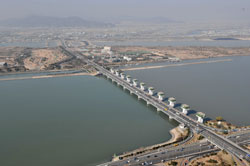By Seonguk Wi of Joongang News
Translated by EAAFP Secretariat
Busan City “Full opening of floodgate expected by 2025”
Restoration of the once-damaged Eulsukdo migratory bird habitat
Seawater affecting agriculture
Persuasion of 18,000 farmers needed

The 2230 m long Nakdong Estuary Bank linking Saha-gu and Gangseo-gu of Busan City was completed in 1987 (Photo provided by Busan City)
Opening Nakdong Estuary Bank’s floodgate has recently become controversial. Mr. Byeongsu Seo, the mayor of Busan City declared, “phased opening will begin from 2017, aiming full opening of the bank’s floodgate by 2025.” Local farmers oppose this and they claimed that “Once the floodgate is opened, it would be impossible to continue farming because of the salinity.” On the other hand, environmental organisations support the idea as it would “restore the ecosystem destroyed by the estuary bank.”
Nakdong Estuary Bank was built in 1987. The bank linking Saha-gu and Gangseo-gu of Busan City has 16 floodgates and is 2230 m long and 18.7 m high. Seawater and river water were separated for two reasons: to increase productivity in the 400 million ? land nearby where the farming was not successful due to salinity and to raise the water level of Nakdong River so that the city can secure water resources for drinking, industrial and agricultural uses. 153.9 billion Korean won was invested into the construction.
As a result of the project, the annual yield near the bank has increased by 20,000 tonnes. Securing over 600 million tonnes of water annually has eased water shortage.
On the other hand, the construction also resulted in substantial environmental destruction. The dredging soil from the river bed was used for reclamation of wetlands nearby for housing and industrial complex. Eulsukdo near the bank used to be one of the biggest sites for migratory birds in East Asia. Especially in the mid-80s there were over a million swans and geese visiting the site every year. This site used to produce an abundance of plankton, shellfish, crabs and fish to accommodate millions of waterbirds. However, after completion of the estuary bank, the number of waterbirds has drastically declined to only about 5-10% of the numbers seen in the 90s.
Additionally, Eulsukdo has been designated as a disposal island for municipal waste, human waste and dredging sand of Busan city. The once-paradise for migratory birds became smelly ‘litter island’. Thankfully, in 2003 Busan City started to manage Eulsukdo and created a migratory bird park. With the city’s effort, some migratory birds have been gradually coming back but the numbers are still only around 200 thousand.
Other plants and animals have also reduced as well. Corbicula clams, which the area was famous for had disappeared completely, along with 30 other species. In recent years, the former President Lee Myung-Bak’s four-river development project caused river water retention and the appearance of green algae in Nakdong River. This caused drinking water shortage again, so the construction of the river bank became pointless. This is why Mayor Seo promised to the public the opening the floodgates of the Nakdong River as one of his election pledges in last September.
Mayor Seo emphasised, “Restoration of the Nakdong River is something that we cannot put off for the sake of the next generation and the future of the Republic of Korea.” Last October, a Task Force was formed under the Office of Waterworks of Busan City to investigate the opening of the estuary bank. The team started to collect the opinion of stakeholders, such as farmers, fishermen and factories to find solutions.
However, there is much to be done. First, consultation with about 18,000 local farmers is required to reach a compromise, especially as opening the floodgates will destroy rice fields and cause financial damage to the farmers. Securing an alternative water source suitable for different uses will not be easy. It will also be difficult to persuade the Ministry of Land, Infrastructure and Transport who has the final decision on this matter.
The chief of Nakdong River Estuary Brackish Water Ecosystem Conservation Council, Gyeongcheol Kim said, “The reopening of the estuary is possible if we raise public awareness of the current situation, which is different from the 80’s and conduct rational discussions with the government and other stakeholders in order to find reasonable options and solutions that would work for all stakeholders and our nature.”
To read the original article (in Korean), click here.




